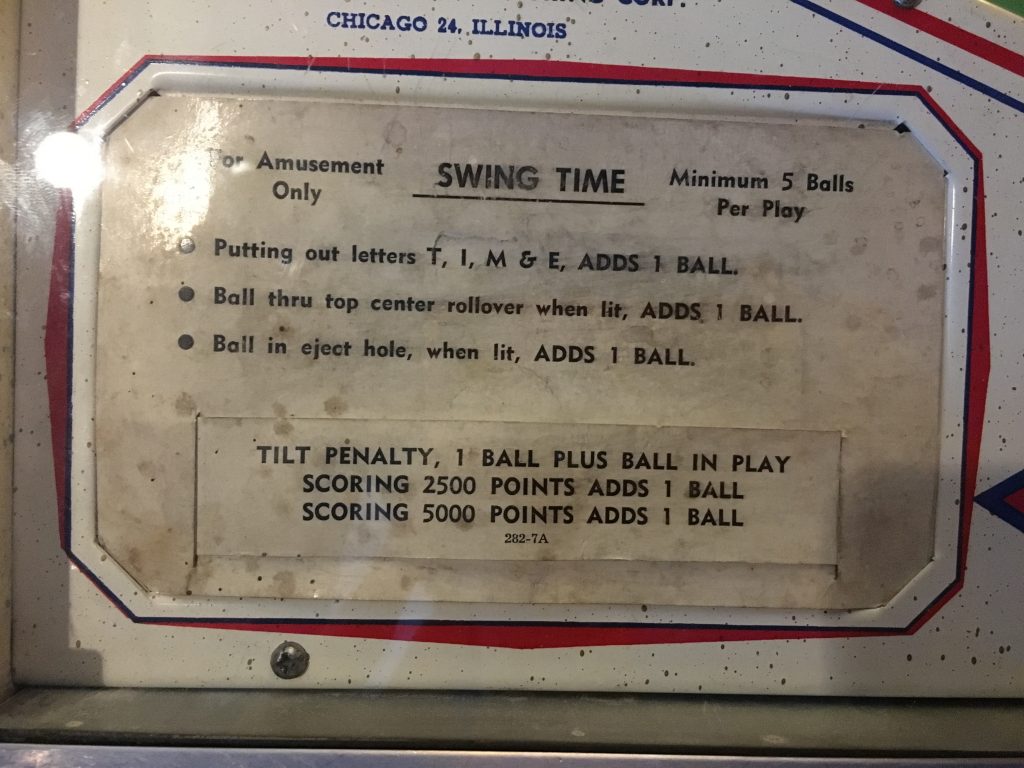
Sometimes you just like bad things, like playing Dustbowl in Team Fortress 2, or using the Kraber Sniper Rifle in Titanfall 1 and 2. Other times you just want to try something so you know what old things will be like, knowing it can’t stack up to the later improvements and developments, like playing the original Killing Floor mod just to see how far Killing Floor 2 has come. Me playing Swing Time was the latter of these two cases.
Before I get into talking about my experience with this game, we should get to know the cabinet I’m talking about.
Name: Swing Time
Date of Manufacture: May 20th 1963
Manufacturer: Williams
One of my favorite part of old cabinets are the literal bells and whistles used to make sound. I’m just a sucker for the sound of the old bells these cabinets use, among other retro aesthetics. Aside from playing a machine that probably would have earned the approval of my grandpa if he were still around to see it, I did want to know what early machines were like. For the sake of science, I grabbed my tokens and dove head first into this old machine.

I was off to a great start, as the moment I stepped up I realized I had no idea where the coin op was. After a bit of help I learned it is the slot near the top of the front panel, offset to the left of center. Second, I learned that the ball return is manual, unlike every other machine in the exhibit. The manual ball return actually felt pretty nice, with a solid ker-chunk sound and feel every time it was pushed in to load a new ball.

“Amusement Only”
No gambling here officer
$0.10 a play? That’s half the price of playing today if you buy 100 tokens for $20
Next was a quick double check of the rules. It was as basic as expected for an old machine, with the most notable mechanic being spelling “TIME” by shooting the ball through the letters at the far end of the playfield. In the year of 2019, we’ve seen this mechanic a dozen times at least so I’ll move on.
From there, I could start playing the game. The flippers were quick and responsive, but they were very short. I felt like the gap between them was way too large for the size of flippers they used. Between the sparse field of unpredictable bumpers and that gap, it felt like the game mostly played itself, and I even had balls roll into the gap right off the break so that ball was just about wasted.

Meanwhile, the other half of that equation, the bumpers, felt a little too powerful and sensitive. They made the game feel more random than anything else I played that day because of how much they bounced the ball around. Especially the ones right above the flippers, which felt inconsistent when they bounced the ball. Sometimes, the ball looks like it’ll roll by just fine when the bumper shoots the ball into the gutter opposite it. Other times I’m sure that ball is about to get shot into space and it rolls straight into my flippers.
That’s not to say I didn’t have fun at all playing the Swing Time cabinet. I did enjoy the number of bells the bumper roulette that the far end of the playfield used. And the flippers could make good contact with the ball, which helped it feel responsive despite the age. I couldn’t do much other than hit the bumpers a lot and spell “TI,” “IE,” or “IM” with each ball, nor could I light up all the three big bumpers in a single play. So really, I never did complete a single objective on the field, but there weren’t many to begin with either. I started to slowly get a feel for how it played, but unlike some of the younger games in the exhibit it just didn’t play as well or as intuitively. A lot is learned in 20-30 years after all.
To sum up playing Swing Time, it was fun as long as I didn’t think about it to much. As machines of this era were, the theme of the machine was just a skin that could have been replaced by any other skin and would have had no effect past changing the look of the cabinet and playfield. It was annoying when it felt like I got screwed by random bumping or my flippers being too short. It was a perfectly ok experience, not too bad but not too good either. Would I play it again? Yes, but only as a guilty pleasure. I don’t think it’s nearly as good a game as pretty much any of the other cabinets on display at the Strong Museum, but like I said before: Sometimes you just like bad things.
If you’re interested in knowing more information about Swing Time, here’s the IPDB entry
